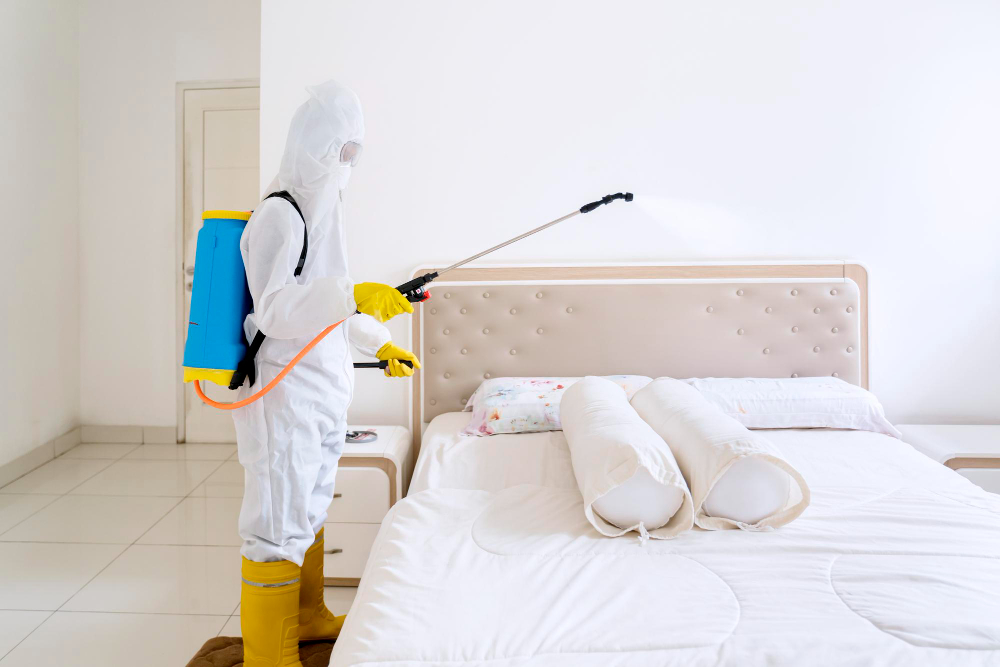
Bed bugs have been a nuisance for homeowners across the centuries. Despite their diminutive size, these pests can create significant problems. Early recognition is key, which makes understanding their habits and early signs of an infestation the first step to an effective eradication plan.
Understanding Bed Bugs
Preferred Habitats and Hiding Spots
Contrary to common belief, bed bugs don't confine themselves to beds. They are clever creatures, taking refuge in cracks, crevices, furniture seams, and even within wallpaper. Their preference is to remain close to their human hosts, with bedrooms being their top choice, but they can also infiltrate other parts of the house.
Mechanisms of Spreading: Travel, Second-Hand Items, and More
Ever wondered how bed bugs infiltrate your home? They are hitchhikers, often entering via luggage, used furniture, or other second-hand items. Living in close quarters, like apartments, can also facilitate their movement from one unit to another.
Identifying a Bed Bug Infestation
Physical Evidence: Bed Bug Shells, Faeces, and Blood Stains
Spotting an actual bed bug is often the initial sign of trouble, but there are subtler indicators. Shed skins or exoskeletons are one such clue. You might also notice tiny rust-coloured stains on your bed sheets from their droppings, as well as small, smeared blood spots left behind after their meal.
Recognising Bed Bug Bites
Bed bug bites can resemble those of other insects, typically appearing as small, red, itchy welts. They may manifest in a straight line or cluster. Although these bites can be irritating, they are not known to transmit diseases. Nevertheless, prompt bed bug eradication is essential to prevent secondary infections.
The Tell-tale Odour of an Infestation
A serious bed bug infestation is often accompanied by a musty odour, reminiscent of damp towels. This peculiar scent, sometimes likened to wet paper, is emitted by bed bugs as a communication pheromone. If your room starts to exude this smell, it is time for a thorough check.
Steps to Getting Rid of Bed Bugs
Preparation for Treatment
Before embarking on the extermination process, preparation is crucial. First, decluttering is essential. It not only reduces hiding spots but also streamlines the bed bugs pest control process. A thorough cleaning is the next step. Vacuum all potentially infested areas, especially around the bed. Finally, gather all possibly infested items for laundering. High heat, typically over 48°C, can kill bed bugs, so a hot wash is recommended.
Non-Chemical Approaches
There are various methods to tackle a bed bug problem. One effective approach is heat treatment. Raising the room temperature above 50°C for a few hours can eliminate both bugs and their eggs. Cold treatments, which involve freezing infested items, can be effective but require ensuring the cold penetrates deep enough to kill all bugs. Another method employs diatomaceous earth, a natural powder that dehydrates and kills bed bugs on contact.
Chemical Approaches
Insecticides can be potent tools in this battle. However, it's vital to choose the right ones and use them safely. Some bed bugs have developed a resistance to common treatments, so ensure you're using a product proven to be effective against them. Always read and follow label instructions and ensure proper ventilation during application.
Integrated Pest Management (IPM)
For a comprehensive approach, consider integrated pest management. It combines non-chemical and chemical solutions, creating a holistic eradication plan. Addressing the problem from multiple angles reduces the chances of a resurgence, ultimately allowing you to rid your house of bed bugs.
Preventing Future Infestations
Regular Inspections: Incorporating a Routine
To keep your home bed bug-free, establish regular checks for these elusive pests. Focus on potential hotspots such as bedrooms, couch seams, and wall cracks. Over time, this routine can save you from more extensive infestations in the future.
Proactive Measures: Investing in Bed Bug-Proof Covers and Bedsheets
Prevent bed bugs from taking up residence in your bed by using bedbug-proof mattresses and pillow encasements. These covers feature small pores, ensuring bed bugs can't infiltrate. They not only prevent infestations but also help contain and eliminate any existing bugs.
Safe Travels: Warding Off Bed Bugs While You’re Away
Travel can unfortunately introduce bed bugs to your home. Protect yourself by inspecting hotel rooms before settling in, keeping your luggage off the floor, and using luggage racks if available. Upon returning home, it's wise to wash and dry your clothes at a high setting to prevent any hitchhiking bugs from invading your home.
Knowledge Sharing: Informing Guests and Neighbours
In apartments or shared housing, bed bugs can migrate between units. Sharing your knowledge can be beneficial. Inform neighbours and guests about preventive measures. This fosters a sense of community responsibility and helps curb the spread of these pests.
When to Seek Professional Help
Assessing the Extent of Your Infestation
There are instances when DIY methods might fall short. If you notice multiple bed bugs at various life stages, or if your efforts don't reduce their numbers, it's time to consider pest control services for bed bugs.
The Advantages of Hiring Pest Control Services
Pest control services bring experience, technical expertise, and specialised tools to the table. They can swiftly assess the situation, identify infestation hotspots, and recommend the most effective treatments. Moreover, they are trained to handle chemicals safely, minimising any potential risks to your household.

